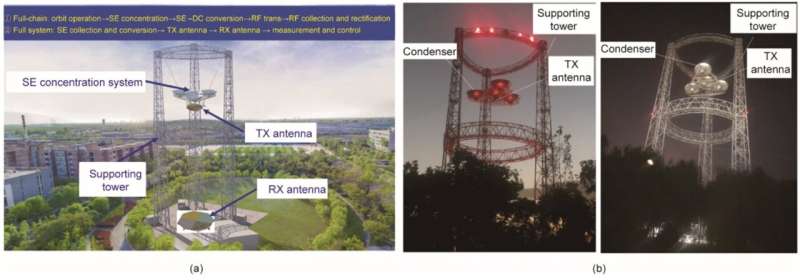

Research team presents design and technology details for space solar-powered sat...
source link: https://techxplore.com/news/2024-01-team-technology-space-solar-powered.html
Go to the source link to view the article. You can view the picture content, updated content and better typesetting reading experience. If the link is broken, please click the button below to view the snapshot at that time.

January 31, 2024
Research team presents design and technology details for space solar-powered satellite
by Engineering

A space solar-powered satellite (SSPS) is a tremendous energy system that collects and converts solar power to electric power in space, and then transmits the electric power to Earth, spacecraft, or moving targets via microwave. It is regarded as one of the most potential ways to solve the problem of energy crisis.
In 2022, a team of researchers from Xidian University in China completed a full-link and full-system ground demonstration and verification system for an SSPS, named the Sun-Chasing Project. Their study, recently published in Engineering, introduces the design concept of OMEGA 2.0 SSPS, the related key technologies, and the development of ground demonstration and verification system for OMEGA 2.0.
In this research, several key technologies of SSPS were tackled, tested, and verified, including high-efficiency solar power collection and photoelectric conversion, microwave conversion, microwave wireless power transmission, beam-forming optimization, accurate microwave beam pointing measurement and control, microwave reception and rectification, and smart mechanical structure design, and more.
In the Sun-Chasing Project, solar power collected by spherical crown concentrators is converted and wirelessly transmitted via microwaves over a distance of 55 m. Over 2 kW of microwave power is transmitted from a circular active phased array with a diameter of 1.2 m, and 87.3% of which is captured by a rectenna with diameter of 5.2 m.
The team said, "The SSPS ground verification system can mimic the key links of a real SSPS in outer space, such as sun tracking, photoelectric conversion, high voltage and large power transmission and management, and smart mechanical structures."
This breakthrough in the design of SSPS ground verification system holds significant potential for advancing the development of a future SSPS. It has the capacity to track the sun, concentrate the collected solar power, convert solar power to direct current (DC) power, beam the power to a rectenna via microwaves, and convert the microwave power back to DC power, which means that it can simulate the full working process of an actual SSPS in outer space.
Thus, this research could pave the way for the development of SSPS in the future. Also one of the key technologies of the work, microwave wireless power transmission technology, may have a wide variety of applications. For example, in the near future, satellites are expected to be equipped with foldable rectenna arrays in place of those bulky solar panels. A transmitting antenna could serve as a power pile to charge satellites equipped with rectenna arrays.
More information: Baoyan Duan et al, On the Innovation, Design, Construction, and Experiments of OMEGA-Based SSPS Prototype: The Sun Chasing Project, Engineering (2023). DOI: 10.1016/j.eng.2023.11.007
Recommend
-
 39
39
James Gosling held a presentation for the Norwegian Java community at an exclusive meetup. This event was presented in cooperation with both the Department of Informatics…
-
 34
34
HIGHLIGHTSSamsung India brings yet another A-series smartphone in India. On Friday, the South Korean smartphone manufacturer launches the Galaxy A70s in the country. This smartphone is special for Samsung India because it is th...
-
 8
8
Leaked Grant Proposal Details High-Risk Coronavirus ResearchThe proposal, rejected by U.S. military research agency DARPA, describes the insertion of human-specific cleavage sites into SARS-related bat...
-
 4
4
CORE VALUESUNIVERSITY: REINVENTEDMost of...
-
 3
3
After last checking in with Pokémon Scarlet and Violet back in June for the official release dates and a first look at the new Legendaries, the...
-
 4
4
Computer, enhance! Microsoft details image enhancing technology for Edge now in testing...
-
 2
2
GameFocalGame servers, powered by technology from spacePayment RequiredAll the power of a VPS with the simplicity of shared hosting. Host Unl...
-
 8
8
API to fetch API endpoint, Organization, Space details for a sub-account Search Questions and Answers ...
-
 2
2
What’s up with the blockchain space? CoinGeek Discussions presents gaming within BSV blockchain Business 5 hours ago
-
 7
7
ON-DEMAND WEBINAR Experience design, technology, and the future of market research...
About Joyk
Aggregate valuable and interesting links.
Joyk means Joy of geeK